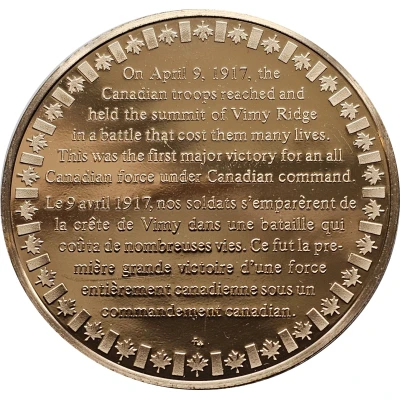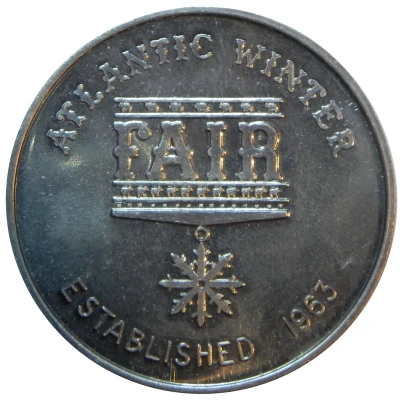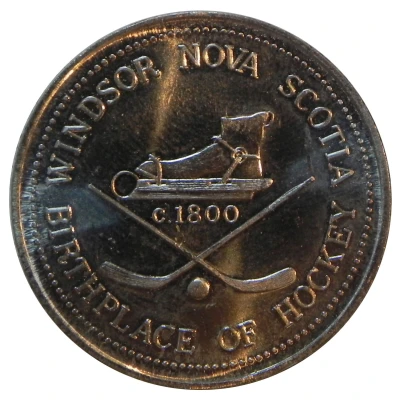


Medal - Medallic History of Canada (Battle of Vimy Ridge) ND
| Bronze | 34 g | 44 mm |
| Location | Canada |
|---|---|
| Queen | Elizabeth II (1952-2022) |
| Type | Medals › Commemorative medals |
| Composition | Bronze |
| Weight | 34 g |
| Diameter | 44 mm |
| Shape | Round |
| Technique | Milled |
| Orientation | Medal alignment ↑↑ |
| Updated | 2024-11-12 |
| Numista | N#429341 |
|---|---|
| Rarity index | 97% |
Reverse
Script: Latin
Lettering:
On April 9, 1917, the
Canadian troops reached and
held the summit of Vimy Ridge
in a battle that cost them many lives.
This was the first major victory for an all
Canadian force under Canadian command.
Le 9 avril 1917, nos soldats s'emparèrent de
la crête de Vimy dans une bataille qui
coûta de nombreuses vies. Ce fut la pre-
mière grande victoire d'une force
entièrement canadienne sous un
commandement canadian.
(Franklin Mint Canada Mintmark)
Edge
Plain with text
Lettering: FRANKLIN BRONZE, C, (Franklin Mint Canada Mark), 74, P
Comment
This was part of a series of 100 historical medals in 2 volumes of 50 made by the Wellings Mint (Wellings Mint was assimilated by the Franklin Mint in 1973). There was a limited run of around 1000 I believe, which is why the edge is numbered.
Made in bronze and sterling silver versions.
The Battle of Vimy Ridge was part of the Battle of Arras, in the Pas-de-Calais department of France, during the First World War. The main combatants were the four divisions of the Canadian Corps in the First Army, against three divisions of the German 6th Army. The battle occurred from 9 to 12 April 1917, marking the commencement of the Battle of Arras and serving as the inaugural assault of the Nivelle Offensive. The objective was to draw German reserves away from the French forces, preparing for a crucial offensive along the Aisne and the Chemin des Dames ridge several days later.
The Canadian Corps were to capture the German-held high ground of Vimy Ridge, an escarpment on the northern flank of the Arras front. This would protect the First Army and the Third Army farther south from German enfilade fire. Supported by a creeping barrage, the Canadian Corps captured most of the ridge during the first day. The village of Thélus fell during the second day, as did the crest of the ridge, once the Canadian Corps overran a salient against considerable German resistance. The final objective, a fortified knoll outside the village of Givenchy-en-Gohelle, fell to the Canadians on 12 April. The German 6th Army then retreated to the Oppy–Méricourt line.
Historians attribute the success of the Canadian Corps to technical and tactical innovation, meticulous planning, powerful artillery support and extensive training, as well as the inability of the 6th Army to properly apply the new German defensive doctrine. The battle was the first occasion when the four divisions of the Canadian Expeditionary Force fought together and it was made a symbol of Canadian national achievement and sacrifice. A 100 ha (250-acre) portion of the former battleground serves as a memorial park and site of the Canadian National Vimy Memorial.



